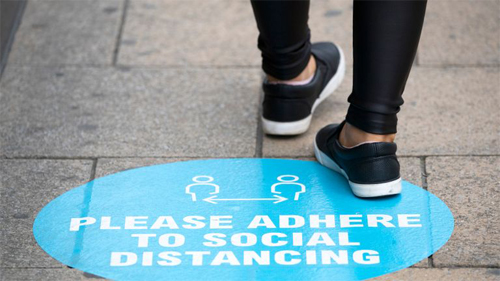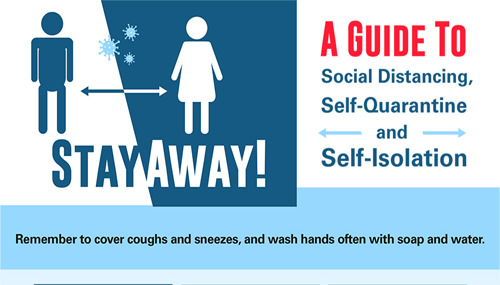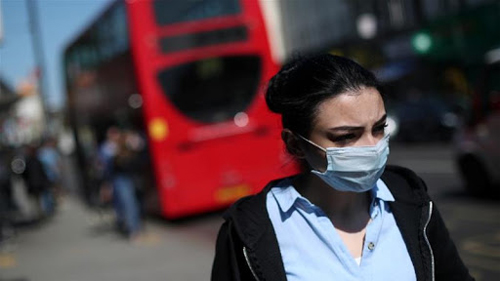Together Apart: the social distance backstory
In the midst of outrage at restrictions on our living arrangements, issued by a UK government that has lost its orientation to reality, two questions arise. The first continues to receive fulsome treatment, at least in non-mainstream media. It is: ‘How can such restrictions be necessary?’ The second is less frequently addressed. It is: ‘How can such restrictions be possible?’ We have, for months, been mulling over, ‘What makes them do it?’ Here, maybe is better to consider, ‘What makes us take it?’

From his isolation bunker, during his quarantine with ‘Covid19,’ prime minister Boris Johnson assured the people of Britain that, after all, there is such a thing as society. This was to reprise a theme of his predecessor, Margaret Thatcher, who famously said, ‘There is no such thing as society.’ In between Thatcher and Johnson, another Conservative prime minister, David Cameron, successfully ran an election campaign based on his vision of a ‘Big Society.’
Despite the wrangling over its extent, what all three recognize is the adjustable character of this thing we call ‘Society,’ which may be emphasized or not, or expanded or not, because it is a function of kinds of government and not, as we might imagine, a set of grass-roots relations between people living out their lives.
It is true, there have always been societies. But when we refer to ‘Society,’ we refer to a quite particular mode of human relations oriented towards the management of populations.
This management has not trod heavily on those populations. It has not ridden roughshod over them or put their noses to the grindstone. On the contrary, it has worked on and through their very hearts’ desires, rendering those desires explicit and tethering them to strategies for their realization. The result: an endlessly satisfied populace whose ways of living are available for infinite readjustment, even wholesale suspension. Our lives are now social lives, and social lives are regulated vertically by abstract concepts and the strategies that apply them, not horizontally between beings in communities. Our lives are now social lives, and they grow more rigid and more meaningless, and more vulnerable to revision and cancellation, every day.
One target of the UK government’s ‘Covid’ restrictions are students at universities, now consigned to virtual life and learning, or, if they arrive at actual halls and campuses, to bubbles and quarantines and curfews. There is disbelief, at such overbearing micro-management of student life. But really, we ought to have seen it coming. Three years ago, before ‘Covid’ was on the horizon, a university lecturer responded to his students’ concerns that they were not being facilitated in efforts to compensate for missing class. He sent them an email, detailing ways in which they might resolve the problem. Among these ways was listed one ‘strategy,’ that of ‘asking a friend,’ for their notes from the class or a verbal summary of its content. The strategy of asking a friend: the easy reciprocity of student relations, apparently not abroad, but compensated for by an institutionally approved strategy for producing a friendship-effect. One thin strand of student life – asking a friend for their lecture notes: separated out, made explicit, recast as a strategy, and returned with a newly-acquired susceptibility to institutional regulation.
Once this is achieved with a sufficient number of strands of student life, the side-to-side associations of student life are cut through by top-down abstractions and the strategies to make them work. No unplanned afternoons drinking beer in the sun – debating ideas just encountered, maybe – only #beerinthesun afternoons, sponsored by a local brewery. No first-day friend from the queue to register for your subject, only the Student-Buddy assigned to you by the Mentoring System. Everything you desire, just as you desire it, only too explicit, too strategic, for life. And as with student friendship, so with friendship generally, which has for some time now been remade as a social phenomenon and thereby brought under careful control.
The average Facebook user has three hundred and thirty-eight friends. Three hundred and thirty-eight. In the Victorian novels, of Dickens for example, characters are often described as having a friend. One friend.
Consider the complex arts of friendship: the sympathy and the judgment, the commonalities and the compromises. How is it possible to negotiate these pleasures and pains with three hundred and thirty-eight?
It is not possible, for even the most virtuosic of friends. Which is why we have acquired this terrible habit – born so innocently of our hearts’ desire for friends: the habit of relinquishing the arts of friendship in favour of ready-made protocols that allow us to negotiate what would otherwise overwhelm.

Just select a response from the dropdown list – a click on the ‘Like’ button will do – and another so-called ‘friend’ is kept happy for now, albeit in fairly rigid style and with possibilities for meaning reduced to having, simply, responded something rather than nothing, and with the so-called ‘friend’ recast as a cypher for strategies of friendship rather than a living breathing being to have and to hold.
Little wonder that asking a friend for notes from a missed lecture has had to be recast as a strategy framed and recommended by an institution. For, friendship now just is a set of social strategies, its gestures selected from easy, ready-made options, less and less reliant upon our active participation but shivering through us as we mouth its script and push its buttons.
We speak now of finding friendship, even of finding love – not of finding a friend or a lover. In our relations with one another, we are mediated through the abstract concept – friendship, love – which blocks horizontal interactions between beings with vertical strategies for realizing social possibilities.
When I find friendship now, when I find love, the person with whom I find it has also found friendship or found love. It is to friendship, or to love, that we both appeal, which are generic possibilities, and not the friend or the lover, who are specific realities. This allows us – compels us, rather – to conduct the relation according to strategies of friendship, strategies of love.
These strategies are ‘oven-ready,’ convenient. But they do bequeath to us a new and enervating task, a task that has come to be synonymous with the social: that of making contact between my friendship and your friendship, my love and your love.
Our mania for contact is born of our rechannelling, as beings whose primary mode of relating is with Society, as social beings.
But contacts are anemic and precarious, not at all like friends and lovers in flesh-and-blood. The administrative satisfactions we may derive from making them and managing them are accompanied by a constant, low-level hum of dissatisfaction, at the poverty of our horizontal living, at the lack of meaningful interaction between us, at our sense that we have yet to find a friend.
We yearn, as a result, for real friendship, but our yearning only leads us through another cycle of social strategizing. On Tinder, men are more likely to attract positive attention if they include in their profile a photo of themselves, taken outdoors with a dog. Presumably, it makes them appear more ‘real,’ the descriptor which is the most commonly used in Tinder biographies.
Such is the rigidity of our modes of interaction, they are effortlessly regulated by a limited stock of explicit and generic concepts and strategies, offered to us on a plate by the social media to which we appeal to solve the problems that it creates.
And the saddest thing: as our relations with one another have been turned strategic, they have begun to require strategies to be endured. Without a strategy, they are overwhelming. Without a strategy, they are an assault. We log onto Facebook, and the assault is immense – three hundred and thirty-eight friends, like nestlings, beaks open, demanding to be fed.
Small wonder we cleave to the strategies; small wonder that once again we move our cursor to the drop-down list and suppress our dwindling capacity for human sympathy with our ever-growing habit of survival.
If one lives horizontal relations, one aims only to survive with the top-down strategies that have replaced them. And the value of surviving comes quietly to exceed the value of living, as we lose our appreciation for the complex nuances of life in our constantly refreshed relief at garish promises of salvation.
Social media is a tautology. The social, for all that it names for us what is desirable in life, the play that compensates for work, that which brings us together, is that which first prised us and continues to prise us apart, that which mediates between us so that our interactions are rigid and predictable, rather than common and habitual, and requiring, therefore, of mediation.
And though we revel in the social skills that allow us to excel on social media, there is always that underlying anxiety, that everything on which the meaning of our lives relies is something from which we might, at any moment, be locked out.
We consult the wealth of guides, which promise us the key – to friendship, to love – because we sense that we are abroad at the behest of Society and that Society can change the rules at any time, and that, if it does, we may find ourselves excluded, without any kind of friend, without even a so-called ‘friend.’
Not so many years ago, the language of ‘reaching out’ to one another began to enter our social interactions – ‘I reached out to Jill the other day; hadn’t seen her in a while’. Our language carries implicit acknowledgements, echoing sadly of our strangeness to one another.

Reaching out, to what is not easily available, to what is retreating, to what may or may not be within our grasp. We’ve been doing it for ten years, perhaps. Not longer than that.
That we are now beyond reach is not something new. That we are now two metres apart. That we are now distanced. A jolt, it seems to us. And yet, what else has been the social in our age than the contracting out of our interactions, their mediation, their micro-management, all of which has set us apart, at a social distance.
Now we are given strategies for hugging. An associate professor in cellular microbiology recommends that we distil our hugging to the hugs that really matter, that we decide whether it is safe ‘to go through with it,’ that we point our faces in opposite directions, that we not touch the other person’s face or clothing with our face.
A professor of comparative virology warns that spontaneous hugging is out of the question. Preparations must be made, hands washed before and after. And the breath should be held. Only strategic hugging, acceptable. Only so-called ‘hugs,’ allowed. It is the endgame of our social mediation, of the separating out and careful administering of the strands of our shared, heretofore real, lives.
Of recent years in the UK, there has been a great propensity for hugging, especially among young people – intense hugging, not just a cursory embrace. Our hugs have seemed forced. As if there was too much at stake. As if not enough comfort could be had. As if, somehow, these were the last hugs in the world. Which now, of course, they were.
The social, despite its branding, is nothing other than distance. And its natural spacing is the six feet in which we are now buried alive. Across which two outstretched arms cannot reach. The depth of a grave.
We might have been more prepared for what Giorgio Agamben has recently observed; we might not see it as contradictory, but as written into the destiny of Society: that the absolute cessation of social relations would ultimately be the maximum form of social participation. Stronger Together is daubed across government sponsored placards in UK shops and public places. But so is Together Apart.
At the very beginning of its ‘Covid’ ‘lockdown,’ the UK government called for volunteers to offer help to those who might need it in the weeks ahead – those living alone, those with infirmities, the old, the vulnerable. The call was immediately answered by seven-hundred-and-fifty thousand people, all with the urge to be a friend to their neighbour but with simply no idea of how to do it. Devising strategies for it at short notice was not the priority, and so reports began to trickle out, of the frustration and disillusionment of the volunteers, almost none of whom was employed in any way.
The impulse remains, then – if only as species memory: the urge to associate with one another, to help one another, to keep one another company. But the urge lacks established horizontal pathways, familiar and embedded outlets to make it effective, to give it meaning. Suspended in thin air, it grows weaker and gasps for breath, and travels more and more unresistingly along the channels set up for it.
How many of those untasked volunteer helpers – how many of the expectant three-quarters of a million, waiting patiently for their friendship assignment – at last spent their drive to be a friend to their neighbour in the hastily cobbled strategy of Clapping for Careers, standing outside their prison-homes every Thursday evening at eight o’clock, squandering their hopes of living together in a meaningful way in another generic and entirely ineffective strategy.
Such reversals of fortune in our would-be horizontal relations, such headings-off of our vestiges of community spirit, do act upon us in the end, sucking the life from our urge to really live together and rendering us as passive applicants to social themes and the strategies that let them filter through our bodies: today we take the knee, tomorrow we take the test, the day after we take the vaccine, our hearts’ desire for real friends callously repurposed as availability for social possibilities, of which we are only the conduits.
Meanwhile, in the first twelve weeks of ‘lockdown,’ seven hundred people in London were reported as having died alone in their home, with no one for company as the curtain fell on their lonely life, with no one even to notice they were gone.
Only the stench of decomposition at last raised the alarm on these friendless souls, some of the vast fallout from the essential indifference, the chilling distance, of our so-called ‘social lives.’
yogaesoteric
January 26, 2021
